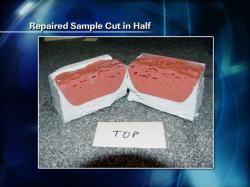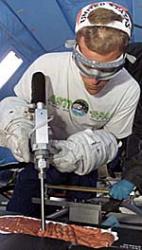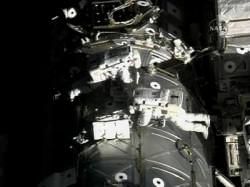Two astronauts tested a special applicator and “goo†to see how well techniques developed for repairing damaged shuttle tiles work in orbit. Shuttle astronauts Mike Foreman and Bob Behnken used a T-RAD, or Tile Ablator Dispenser to squirt a pink, caulk-like substance called Shuttle Tile Ablator-54 into intentionally damaged shuttle tiles during their six and a half hour spacewalk to test how the tool and material behaves in the weightless vacuum of space. “I’m thrilled with what we saw today,” said ISS flight director Dana Weigel after the spacewalk, adding that T-RAD could also be used to mend torn shuttle insulation blankets. “It behaved very similar to what we saw on the ground, so that gives me a lot of confidence.”
The sample tiles and tools will be returned to Earth to undergo extensive testing on the ground. NASA engineers developed the shuttle tile repair tool after the 2003 Columbia disaster to fix dings in the thousands of ceramic tiles on the shuttle’s underside. “We’ve tested this material on the ground, but have not been able to test it in weightlessness and vacuum at the same time, so we hope to characterize how it performs,†said astronaut Mike Foreman before the spacewalk.
“It’s going to be really valuable to have actually have a test of this in case we ever need this in our bag of tricks for repairing a shuttle, particularly with the Hubble mission upcoming,†astronaut Bob Behnken said from orbit.

One of the compounds making up STA-54 causes bubbles to form. On Earth, those bubbles typically rise to the top. The spacewalkers found that with the absence of air or gravity, the bubbles tended to spread throughout the material causing it to bulge slightly in a phenomenon known as “bread loafing.”
Engineers were worried that it might bulge too much, and could cause the material to swell up over the surface layer of surrounding tiles, disrupting air flow during re-entry and causing excessive downstream heating. But during the tests in Thursday’s spacewalk, however, the STA-54 appeared not rise or bubble as much as was anticipated. While bubbles formed, the astronauts were able to use pads to tamp the material down and as the STA-54 “set up,” the swelling seemed to diminish.
“It goes down really well,” Foreman said as he tamped down the thick goop with a sponge-like tool. “It really is like a loaf of bread with a lot of little bubbles in there.”

The astronauts did the tests on the nadir or underside of the Destiny module, using a suitcase-like kit filled with tile samples. There were several different samples with both big and small holes. The spacewalkers worked on this task for several hours, which took up the majority EVA’s duration.
The spacewalkers also performed a few other get-ahead tasks and replaced a failed Remote Power Control Module – essentially a circuit breaker – on the station’s truss. They were unable, however, to unplug a stuck electrical connector from a patch panel in the station’s Z1 truss that would have re-routed power to one of four control moment gyroscopes that helps stabilized the stations attitude. CMG-2 and CMG-3 were wired into the same circuit in the wake of an earlier failure and the cable change was needed to hook CMG-2 back up to its own power supply, restoring lost redundancy. But with the spacewalkers unable to make the change, a single failure could take out both CMGs, a situation NASA wanted to correct.
This was the 108th spacewalk for station construction and maintenance. Behnken and Foreman will begin the mission’s fifth and final spacewalk Saturday at 5:23 p.m EDT.
Original News Sources: NASA TV and CBS Space Place


No doubt, this will find some application here on the ground. Odd, yet groundbreaking in a way (particularly for the Shuttle crews, unsurprisingly would like to make it back home in one piece).
It’s these experiments & tests of application of technology that help to rpovide more robust materials for future missions & earth-based applications